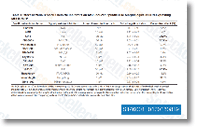HLB has also previously been controlled by penicillin carbendazin, In an earlier study, the combination of penicillin and streptomycin was uncovered to be effective in eliminating or suppressing the Las bacte rium, as well as the mixture supplied inhibitor Lenvatinib a therapeutically helpful level of management to get a a lot longer time than when either antibiotic was administered individually. To increase the throughput of bacterial detection, 16S rRNA gene based phylogenetic evaluation has become com monly employed to characterize microbial diversity, A high density 16S rRNA gene oligonucleotide microarray, the PhyloChip, has not too long ago been created and result ively utilised to review bacterial population diversity.
Its par ticularly inhibitor Ridaforolimus adept at identifying bacteria inside the environment, as well as a recent study to the bacterial diversity in HLB affected citrus employed the PhyloChip G2 and 16S rRNA gene cloned libraries, The updated PhyloChip gene ration three involves 1. 1 million probes, the inclusion of strain exact probe sets, the skill to detect above 50,000 operational taxonomic units, and in excess of 320,000 se quences within the reference database, which can be in excess of ten instances higher than that for your PhyloChip G2, Right here, we implemented the PhyloChip G3 array to investigate the distinctions during the relative abundance and phylogenetic diversity of the bacterial communities linked with HLB impacted citrus plants from the discipline above a increasing season and those handled with antibiotic combinations.
Benefits Dynamic variations of the bacterial neighborhood in HLB affected area citrus By far the most prevalent bacterial phylum in citrus leaves in October 2010 was Proteobacteria with an regular of  one,301 OTUs out of 2,948 OTUs, The next most prevalent phylums have been the Firmicutes along with the Actinobacteria, The amount of OTUs in the Bacteriodetes decreased at a statistically important degree concerning October 2010 and April 2011, and that variation appeared for being concentrated from the class of Flavobacteria. Whilst the phylum Proteobacteria itself remained at 44% from the bacterial local community, the quantity of OTUs within the proteobacterial and B proteobacterial lessons decreased significantly, Amid the proteobacteria, the orders Rhizobiales and Sphingomonadales had decreased OTUs, and among the B proteobacteria the purchase Burkholderiales had decreased OTUs, While the amount of OTUs from the proteobacteria like a class in creased, they decreased during the purchase Pseudomonadales, The increase from the proteobacterial class was statistically vital, and the difference appears concen trated while in the Enterobacteriales, This was the sole member of the bacterial community to show an in crease from the variety of OTUs in April 2011 over October 2010.
one,301 OTUs out of 2,948 OTUs, The next most prevalent phylums have been the Firmicutes along with the Actinobacteria, The amount of OTUs in the Bacteriodetes decreased at a statistically important degree concerning October 2010 and April 2011, and that variation appeared for being concentrated from the class of Flavobacteria. Whilst the phylum Proteobacteria itself remained at 44% from the bacterial local community, the quantity of OTUs within the proteobacterial and B proteobacterial lessons decreased significantly, Amid the proteobacteria, the orders Rhizobiales and Sphingomonadales had decreased OTUs, and among the B proteobacteria the purchase Burkholderiales had decreased OTUs, While the amount of OTUs from the proteobacteria like a class in creased, they decreased during the purchase Pseudomonadales, The increase from the proteobacterial class was statistically vital, and the difference appears concen trated while in the Enterobacteriales, This was the sole member of the bacterial community to show an in crease from the variety of OTUs in April 2011 over October 2010.
Microrna Array
MiRNAs appear to target about 60% of the genes of humans and other mammals.
